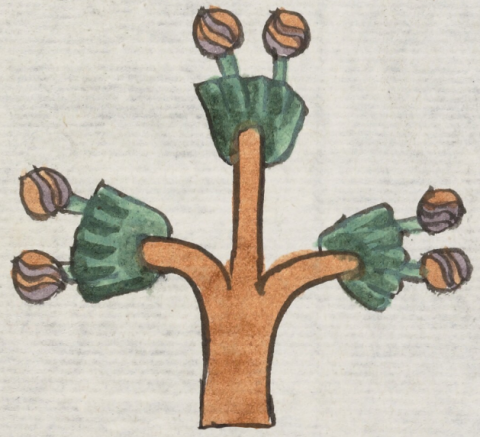tzapotl (Mdz18r)
This glyph for the tzapotl fruit tree (zapote, in Spanish, and sapote, in English) still includes the stones (tetl) that are on the tips of the branches. The combination really is a compound glyph for the place name Tetzapotitlan. The tree consists of a trunk, a leader, and two more branches. The trunk is earth-tone, as are the branches. The greenery on the branches is a two-tone green. Protruding from each branch's greenery are two stems, each one with a stone at the end (where the fruit normally appear). The term for the fruit is tzapotl; in Book 11 of the Florentine Codex the tree is called a tzapocuahuitl.
Stephanie Wood
In the other examples of the tzapotl (zapote, sapote) trees that we have from various compound glyphs (below right), we see green balls (an apple-like fruit) in lieu of the stones. Some of these trees have one, two, or three fruits per branch. Alonso de Molina translates tzapotl as "cierta fruita conocida," a type of fruit that is known (i.e. locally]. Some call this tree the Mexican apple, or "sapote tree" in English. According to Wikipedia, the fruit is edible, it contains pharmacological properties such as histamines, and the seeds may have been used by the Aztecs to make poison.
Stephanie Wood
c. 1541, but by 1553 at the latest
Stephanie Wood
trees, branches, roots, árboles, ramas, raíces, fruits, frutas

tzapo(tl), sapote, a fruit tree, https://nahuatl.wired-humanities.org/content/tzapotl
el árbol zapote
Stephanie Wood
Codex Mendoza, folio 18 recto, https://digital.bodleian.ox.ac.uk/objects/2fea788e-2aa2-4f08-b6d9-648c00..., image 46 of 188.
The Bodleian Libraries, University of Oxford, hold the original manuscript, the MS. Arch. Selden. A. 1. This image is published here under the UK Creative Commons, “Attribution-NonCommercial-ShareAlike 3.0 License” (CC-BY-NC-SA 3.0).









